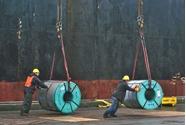Steel Products Prices North America

Anti-Dumping & Countervailing Duty Trade Cases
Written by John Packard
March 21, 2015
We thought we would take one last stab at the subject of Anti-Dumping (AD) and Countervailing Duties (CVD) since we received more detailed information from attorney Lewis Leibowitz:
The question of time lines for AD/CVD cases can fill many pages. There are rules, exceptions and discretion (mostly Commerce) that can alter the time lines. Your friend could use a session on this.
Here are the basics:
1. There are four basic determinations: ITC preliminary and final; and Commerce preliminary and final. In an AD case, if both dumping and injury are found in the final determination, Commerce will issue an AD order. In a CVD case, if both subsidies and injury are found, CVD order will be issued.
2. The determinations and their timing (assuming no extensions) are:
a. ITC preliminary injury (45 days after petition is filed)
b. Commerce preliminary AD (160 days after petiton) (in a CVD case, 85 days after petition)
c. Commerce final AD (75 days after preliminary Commerce determination)(in a CVD case, 75 days after the Commerce CVD preliminary determination)(if both kinds of cases are involved for the same product, Commerce will often “align” the final determinations on the due date for the AD final).
d. ITC final injury (45 days after publication of Commerce final determination)
e. AD or CVD order (about 7 days after publication of ITC final determination)
3. Significance of each determination:
a. ITC preliminary injury: if affirmative, investigation continues. If negative, investigation is terminated.
b. Commerce preliminary: if affirmative, covered goods are potentially subject to duties and will be subject to “suspension of liquidation” and cash deposits of estimated duties (AD and CVD) as applicable. If negative (no dumping, no subsidies), investigation continues but no duties and no deposits. This is a key date for importers.
c. Commerce final: duty rates may be revised. If affirmative, suspension of liquidation continues (as do cash deposits at the new rates). If negative, investigation terminates.
d. ITC final injury: if affmative, AD and/or CVD order will issue. If negative, investigation terminates.
4. Entries covered: entries for consumption (sold in the US) are covered if entries are on or after the date of publication of the preliminary determination of Commerce in an investigation. Under Customs law, there are several types of entries. Coverage of each type is complex.
5. Potentially, duties can be applied retroactively (“critical circumstances”) to entries 90 days before the Commerce preliminary determination. That subject requires a separate discussion. For present purposes, it rarely happens but it can be quite scary for importers.
6. Administrative reviews are conducted annually if requested. The review (by Commerce only) looks at entries over the previous year. The duties can vary significantly from the cash deposit amounts. In general, if the final duties are higher than the cash depoaits, the importer will be liable for the difference. If the final duties are lower, the importer gets a refund. The exporter/producer gets a new rate for future entries. The review process takes about one year. For an order entered in January 2016, for example, the review will be initiated in Feb. 2017 and the final results of the review will come out in 2018. Long process.
Determinations of Commerce and the ITC may be subject to court review. That is a separate discussion too.

John Packard
Read more from John PackardLatest in Steel Products Prices North America

Nucor slows HRC price climb with $5/ton increase
After eight weeks of double-digit price increases on hot-rolled (HR) coil, Nucor slowed the price rise this week with an increase of $5 per short ton.

Domestic CRC prices surge ahead of imports
The price spread between stateside-produced CR and imports reached its widest margin in over a year.

Evraz raises plate prices $160/ton
Evraz North America (NA) has followed Nucor and SSAB with a plate price increase of its own: up $160 per short ton (st). The increase was effective immediately for all new orders of carbon, high-strength low-alloy, and normalized and quenched-and-tempered plate products, as well as for hot-rolled coil, the steelmaker said in a letter to […]

Nucor lifts HR coil to $820/ton
Nucor has increased its consumer spot price (CSP) for hot-rolled (HR) coil for a fourth consecutive week.

Nucor pushes HR spot price to $790/ton
Nucor increased its consumer spot price (CSP) for hot-rolled (HR) coil to $790 per short ton (st) on Monday, Feb. 10 – a $15/st bump vs. last week. The Charlotte, N.C.-based company has raised its weekly CSP by $40/st over the past three weeks after maintaining tags at $750/st since Nov. 12, according to SMU’s […]
